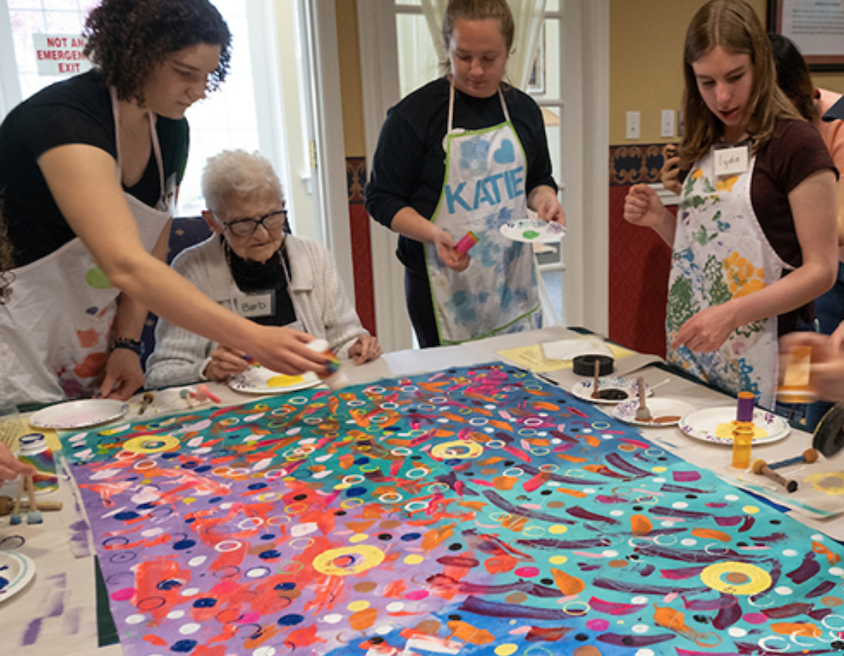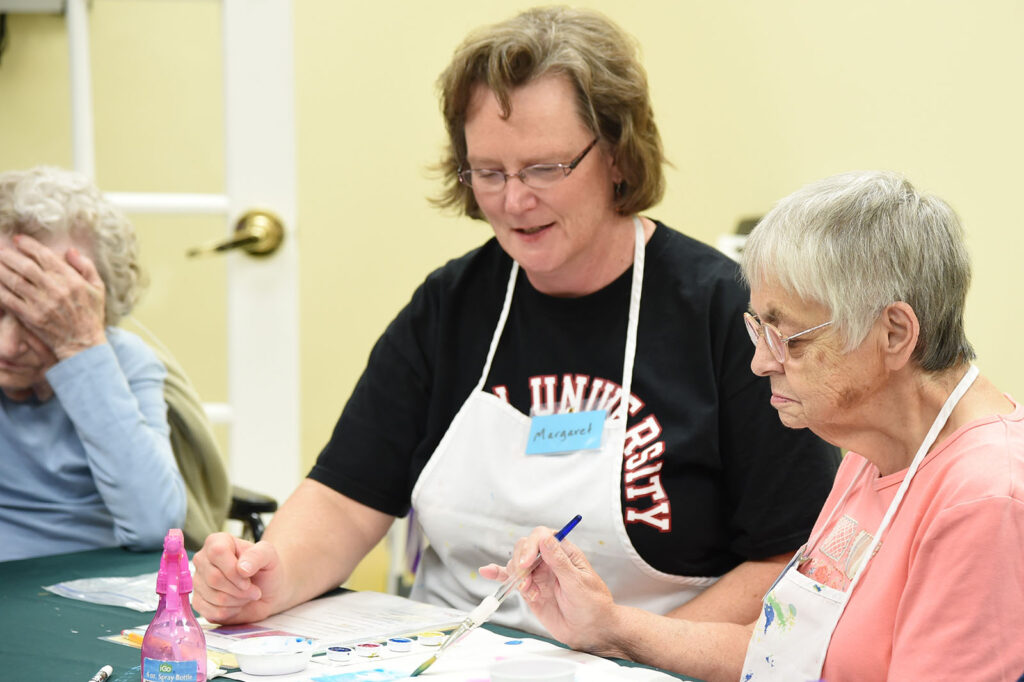Improving Accessibility with Adapted Art Tools
Through its person-centered approach, Opening Minds through Art (OMA) plays to the strengths of its artists, who have unique needs as People with Dementia (PWD). In addition to changes in cognitive function, it is possible that the artists may have other physical or neurological factors that affect their ability to participate fully in OMA activities, such as low vision, arthritis, decreased strength or coordination, or impaired sensation. By adapting the physical components of the OMA projects and tools, and with continued emphasis on autonomy and engagement, we can improve the overall accessibility of the OMA experience and allow more opportunities for increased well-being in the artists we serve
The following instructions provide methods and materials to create simple adaptations for art tools. With this “toolkit,” OMA facilitators and volunteers can easily modify rollers, stamps, brushes, and other tools for an artist’s individual needs. All you need is your creativity and ingenuity!
Once you’ve created your toolkit, familiarize yourself with it through play! Encourage volunteers to test the many combinations of tools and grips so they have a greater understanding of which adaptation will address the needs and be most beneficial to the artist. It may take some trial and error to determine which adaptation best fits the artist’s individual needs, and what works for one may not work for the next. Remember, autonomy is still essential to OMA; you may explain and demonstrate how the adaptation is used, but the artist makes the final decision on whether or not they would like to use the adapted tool!
Materials List
- foam hair rollers
- hair bands
- tennis ball
- pool noodle
- milk/juice jug handle
- clothespin
- film canister, pill bottle, empty thread spool
- ½” PVC pipe, ½” caps, ½” T joint (not threaded)
- ½” caps, ½” PVC pipe, ½” T joint (threaded), ½” male to ¾” female joint, ¾” PVC pipe
- 1/4” hex nuts
- 5/16” hex nuts
- 5/8” hex nuts
- painters tape (to create borders, to add circumference to a paint brush handle or pencil, to stabilize materials)
- Any other materials- be resourceful!


Materials:
Film canister, pill bottle, empty thread spool, clothespin
Instructions:
Use hot glue or another adhesive to attach your chosen item to a sponge, stamp, or other art tool for a permanent adaptation. For a quick, temporary way to adapt, pinch a clothespin on instead.
Purpose:
The artist can use a larger grasp pattern to hold the object rather than having to pinch it. This is helpful if the artist has decreased strength and coordination, or finds pinching to be painful.


Materials:
Handle from milk jug or juice container
Instructions:
Cut the handle off your container, making sure there aren’t any sharp edges. Insert marker or other writing utensil into the handle. This may work to adapt other tools in addition to markers.
Purpose:
The jug handle adds circumference to the writing utensil and wraps around the fingers, which may prevent dropping or help if the artist is unable to fully grasp the tool.


Materials:
Foam hair rollers, hair bands, hex nuts
Instructions:
Using scissors, cut a small section or “window” out of a foam hair roller. Thread the brush handle through one end of the roller, add hex nuts as needed, then thread the handle through other end of the roller, encasing the nuts. For brushes or writing utensils with larger handles, hair bands can be used to hold the hex nuts in place.
Purpose:
The added weight of the hex nuts can assist artists in applying pressure to create marks on paper. Some artists who have tremors may find the added weight beneficial. Artists who have impaired sensation may find the added weight improves their perception, coordination, and manipulation of a brush. The foam hair roller provides cushion between the artist’s hand and the hex nuts.


Materials:
Tennis ball, pool noodle, foam hair roller
Instructions:
Carefully cut two holes in a tennis ball and thread a brush handle or writing utensil through them. I suggest using a vice and an awl or sharp knife to create a hole or “X.” A “dead” or older tennis ball may be easier to puncture. A pool noodle can be cut easily with an electric knife. Insert a foam hair roller into the pool noodle, then thread your tool through. If a smaller amount of additional circumference is needed, use a foam roller alone or build up the handle by wrapping it with painters’ tape.
Purpose:
These adapted grips allow artists to use different grasp patterns and provide a larger object to grasp, which may benefit those who have decreased strength and coordination or find gripping a pencil or brush to be painful.


Materials:
PVC pipe and fittings, foam hair roller
Instructions:
Use PVC pipe and fittings to create T-grips to fit different tools.
For tools with larger handles:
Cut 2 short sections of ½” PVC pipe and insert into ½” threaded T joint, then place a ½” cap on each end. Screw a threaded ½” male to ¾” female adapter into the threaded T joint. Cut a section of ¾” PVC pipe to the appropriate length to fit the tool you are adapting. Insert into adapter, check length, and file any rough edges. Place a foam hair roller around the handle of your tool, then insert it into the ¾” PVC pipe. Fitting the handle and roller into the PVC pipe may take some trial and error.
For tools with smaller handles:
Cut 2 short sections of ½” PVC pipe and insert into ½” T joint, then place a ½” cap on each end. Cut another section of ½” PVC pipe to the appropriate length for the tool you are adapting, then insert into the T joint. File any rough edges and use a foam hair roller to fit the handle into the PVC pipe.
Purpose:
A T-grip provides an alternative way to grip and coordinate the use of tools, especially rollers.
Techniques for Addressing Low Vision:
For artists who have low vision, it may be helpful to provide a contrasting border around their paper with painters’ tape. Brighter lighting and colors may be easier to see, as are larger items. Using textured items for increased tactile input may improve the artists’ abilities to engage in the activity without relying on vision (for example, using a foam roller to help orient where to grasp a brush or creating raised borders by placing corrugated cardboard with a window cut out over the area to paint).

Developed and contributed by Ingrid Derstine, OTD, OTR/L. Ingrid recently completed her occupational therapy doctorate degree at Virginia Commonwealth University. As part of her doctoral coursework, Ingrid interned with Art for the Journey, assisting them in training new OMA facilitators and examining the impact of their painting classes on stress management, emotional regulation, and leisure participation. Ingrid has been a trained OMA facilitator since February of 2018.
If you have any questions about the above adaptations, please contact Ingrid Derstine, OTD, OTR/L, at derstinei@mymail.vcu.edu.


